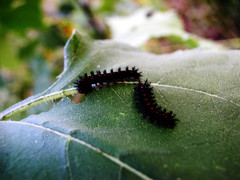 Image by Jason A. Samfield via FlickrThe word natural sounds safe and welcoming. It indicates that something is safe because it comes from nature - it sounds like something you can trust. But anything used in excess can become a negative thing. Anything used in the wrong way or in the wrong combination can become harmful. So it is with natural insecticides.
Image by Jason A. Samfield via FlickrThe word natural sounds safe and welcoming. It indicates that something is safe because it comes from nature - it sounds like something you can trust. But anything used in excess can become a negative thing. Anything used in the wrong way or in the wrong combination can become harmful. So it is with natural insecticides.Wise use means using responsibly. Wise use means you know how the product can be harmful so that you make no mistakes with it. Natural insecticides have become more popular as the concern about the earth's safety and preservation has become more and more prevalent. But natural insecticides can still be damaging to pets, to plants, and even to people if used improperly.
You have to know the proper application, how much to use at a time (more is not always best), and what precautions to take while you are using the insecticide. If you plan your garden wisely, you may not even need insecticides at all. There are certain plants that repel insects, and many good insects that can safely dispose of the not-so-good ones.
 Image via WikipediaFor example, many people think wasps are bad. And they can be if someone is allergic to them and gets stung. They can be if a mischievous child irritates them just to see how angry they can get. But wasps are also good for our environment. They are not just insects that can harm; they are a positive force as biological control for our agricultural crops. They help keep caterpillars under control. If you wonder why this is helpful, ask the farmer or gardener whose crops are ruined by the caterpillars. If the crops suffer, we suffer as prices rise because of the damage that is done to reduce availability. Developing a pest management program is wiser than over-use of pesticides, whether they are natural or not. If you must use a pesticide because of the location of the wasps or because they have become out-of-control around your home or property, at least wise up about the best way to do so.
Image via WikipediaFor example, many people think wasps are bad. And they can be if someone is allergic to them and gets stung. They can be if a mischievous child irritates them just to see how angry they can get. But wasps are also good for our environment. They are not just insects that can harm; they are a positive force as biological control for our agricultural crops. They help keep caterpillars under control. If you wonder why this is helpful, ask the farmer or gardener whose crops are ruined by the caterpillars. If the crops suffer, we suffer as prices rise because of the damage that is done to reduce availability. Developing a pest management program is wiser than over-use of pesticides, whether they are natural or not. If you must use a pesticide because of the location of the wasps or because they have become out-of-control around your home or property, at least wise up about the best way to do so.There are natural insecticides that are so toxic that we must cover our faces to avoid ingestion while using them. One such product is the dust of diatomaceous earth. Even though it is a form of calcium, and calcium is a useful mineral, we must take care when applying it for insect control. The minute particles are not good for our lungs. Any dust that is inhaled excessively can be harmful. (I use this one a lot - it's not so hard to keep from inhaling it - just be sure not to apply when it is windy!)
Rotenone is a botanical insecticide extracted from the roots of certain plants in Asia and South America. If you use this substance unwisely, you can damage your fish and beneficial insects. It causes stomach poison in insects, acts slowly, and loses effectiveness a week after being used on the plants. But if you inhale unsafe amounts of this insecticide, you could be sick longer than a week. Wise use of it can control aphids, some beetles, fleas, lice, and some caterpillars. So, if you don't want to hurt your butterfly population, you may want to choose another type of insect control.
Of course, some natural insecticides are more harmful than others. Some can be very helpful for your garden when other methods have failed. Just remember to always wash your hands, cover your nose and mouth, avoid using them on windy days, and be careful with them around small children and animals.



